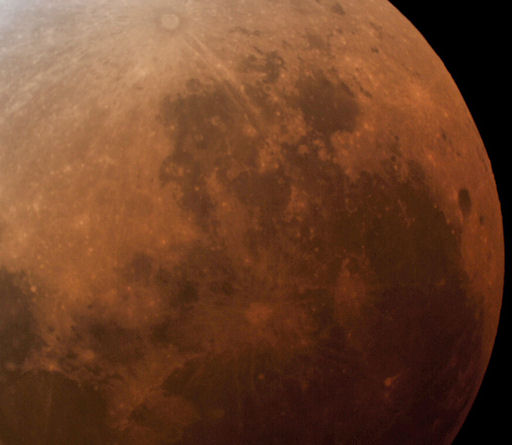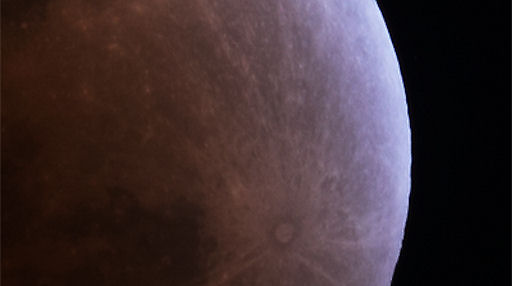~SPACE WEATHER UPDATE 12~11~11 ENTERING A SOLAR WIND STREAM~
SOLAR WIND: Earth is entering a minor solar wind stream that could spark auroras around the Arctic Circle. High-latitude sky watchers should be alert for Northern Lights tonight. Aurora alerts: text, voice
TOTAL LUNAR ECLIPSE: Yesterday, sky watchers across the Pacific side of Earth witnessed a total eclipse of the Moon. During its transit through Earth's shadow, the Moon turned a bright copper color. The hue was meaningful to scientists who monitor lunar eclipses as part of their research on climate change. More on that below, but first regard this snapshot taken by James Barclay of Maidenwell, Queensland, Australia:
"The Moon looked like some alien planet hanging in a star-studded sky," says Barclay. "The excitement of those who witnessed this event will never be forgotten."
Dec. 10th Total Lunar Eclipse Gallery
Atmospheric scientist Richard Keen of the University of Colorado watched the event from Hawaii: "We had a fine warm morning for the eclipse here near Hale'iwa on Oahu'a North Shore. The eclipse was accompanied by the thunder of surf from the Banzai Pipeline, where later in the day surfers competed for the perfect ride," he says.
Keen wasn't just enjoying the view; he was also analyzing the event for scientific purposes. Lunar eclipses offer a unique way to assess the global dustiness of Earth's stratosphere. The scattering action of dust casts a red light into Earth's shadow. Lots of dust yields a deep red eclipse, while less dust produces a bright coppery hue.
The bright copper color of yesterday's eclipse suggests that the stratosphere is relatively clear. "My preliminary measurement of the brightness of the eclipse is magnitude -2.5 at mid-eclipse," says Keen. "It appears the clear stratospheric conditions of recent years is continuing."
This is important because the stratosphere affects climate; a clear stratosphere "lets the sunshine in" to warm the Earth below. At a 2008 SORCE conference Keen reported that "The lunar eclipse record indicates a clear stratosphere over the past decade, and that this has contributed about 0.2 degrees to recent warming."
The stratosphere has another effect on lunar eclipses. Note the soft blue colors in this picture from Shahrin Ahmad of Teluk Kemang, Malaysia:
This is the "turquoise fringe" often seen during total lunar eclipses. Keen explains: "Light passing through the upper stratosphere penetrates the ozone layer, which absorbs red light and actually makes the passing light ray bluer. This can be seen as a soft blue fringe around the red core of Earth's shadow."

Solar wind
speed: 462.1 km/sec
density: 2.3 protons/cm3
explanation | more data
Updated: Today at 1615 UT
X-ray Solar Flares
6-hr max: B9 1137 UT Dec11
24-hr: C1 0002 UT Dec11
explanation | more data
Updated: Today at: 1600 UT
![]()
Daily Sun: 09 Dec 11
The face of the sun is peppered with spots, but none poses a threat for strong solar flares. Credit: SDO/HMI
![]()
Sunspot number: 90
What is the sunspot number?
Updated 08 Dec 2011
Spotless Days
Current Stretch: 0 days
2011 total: 2 days (<1%)
2010 total: 51 days (14%)
2009 total: 260 days (71%)
Since 2004: 821 days
Typical Solar Min: 486 days
Updated 08 Dec 2011
The Radio Sun
10.7 cm flux: 145 sfu
explanation | more data
Updated 08 Dec 2011
![]()
Current Auroral Oval:
Switch to: Europe, USA, New Zealand, Antarctica
Credit: NOAA/POES
![]()
Planetary K-index
Now: Kp= 2 quiet
24-hr max: Kp= 3 quiet
explanation | more data
Interplanetary Mag. Field
Btotal: 4.8 nT
Bz: 1.4 nT north
explanation | more data
Updated: Today at 1617 UT
![]()
Coronal Holes: 09 Dec 11
There are no large coronal holes on the Earthside of the sun. Credit: SDO/AIA.
http://spaceweather.com/






